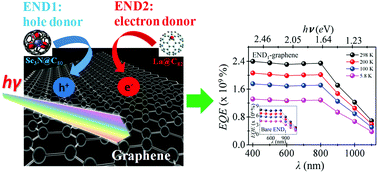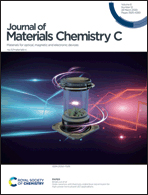Sc3N@C80 and La@C82 doped graphene for a new class of optoelectronic devices†
Abstract
High-performance hybrid graphene photodetectors were prepared with endohedral fullerenes deposited on graphene using electrophoretic methods for the first time. Endohedral Sc3N@C80, which acts as an electron acceptor, was used and the ensuing electronic and optoelectronic properties were measured. Another endohedral fullerene, La@C82, was also adsorbed on graphene, which acts as an electron donor. Upon optical illumination, for the Sc3N@C80–graphene hybrid, the photoinduced free holes are injected into graphene, increasing the hole carrier concentration in graphene, while the photoexcited electrons remain in Sc3N@C80; this leads to a high photoresponsivity  of ∼109 A W−1, detectivity D of ∼1015 Jones, and external quantum efficiency EQE ∼ 109 % for the Sc3N@C80–graphene hybrid. This
of ∼109 A W−1, detectivity D of ∼1015 Jones, and external quantum efficiency EQE ∼ 109 % for the Sc3N@C80–graphene hybrid. This  is ∼10 times higher compared to other reports of quantum dot-graphene and few layer MoS2–graphene heterostructures. Similarly, for the La@C82–graphene hybrid,
is ∼10 times higher compared to other reports of quantum dot-graphene and few layer MoS2–graphene heterostructures. Similarly, for the La@C82–graphene hybrid,  ∼ 108 A W−1, D ∼ 1014 Jones, and EQE ∼ 106 % were achieved, with electrons being injected into graphene. The exceptional performance gains achieved with both types of hybrid structures confirms the potential of endohedrals to dope graphene for high performance optoelectronic devices using a facile and scalable fabrication process.
∼ 108 A W−1, D ∼ 1014 Jones, and EQE ∼ 106 % were achieved, with electrons being injected into graphene. The exceptional performance gains achieved with both types of hybrid structures confirms the potential of endohedrals to dope graphene for high performance optoelectronic devices using a facile and scalable fabrication process.



 Please wait while we load your content...
Please wait while we load your content...
